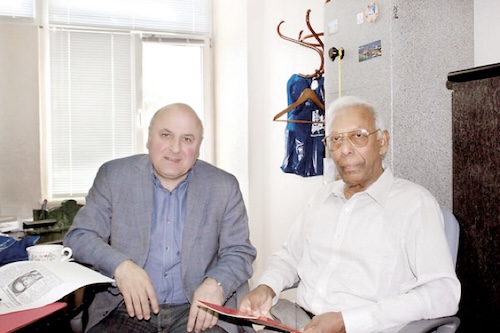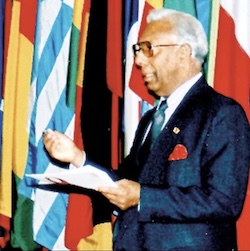By Somar Wijayadasa*
NEW YORK | 28 January 2025 (IDN) — Russia’s People’s Friendship University in Moscow—widely known as the RUDN—an acronym derived from its Russian name (Российский Университет Дружбы Народов) celebrates its 65th Anniversary on 5 February 2025.
Just three years after he opened the former Soviet Union (USSR) to the world with the 1957 Youth festival in Moscow, Soviet Premier Nikita Khrushchev opened Russia’s People’s Friendship University, in February 1960.
It was also the ideal time for the former Soviet Union—already basking in the glory of a superpower—not only to show the world its radical transformation of the country that was ravaged by the World War II with a loss of over 27 million of its people, but also to display its many scientific and technological advances including its Space Program—already ahead of the United States.
In 1962, when I was a law student in the Ceylon Law College, Sri Lanka, I won a scholarship to specialize in International Law at the Friendship University. As an alumnus and a frequent visitor to the RUDN University, I had the rear privilege to witness the astounding metamorphosis of this University from 1960 to date.

Educating the newly liberated developing countries
The primary objective for creating the RUDN University was to educate young people from the newly liberated countries in Asia, Africa and Latin America.
The mass decolonization began after World War II when the principle of “equal rights and self-determination of peoples” was enshrined in the United Nations Charter and the UN began to fight for the liberation of these countries.
In 1945, the United Nations consisted of 51 member states and by 1965, the number had more than doubled to 117, as the newly liberated nations joined the organization. These young nations—ruined by colonization and exploitation—needed qualified cadres to resurrect their ruined economies, and the Russians stepped into help.
Thus, over the past 65 years, the RUDN trained thousands of qualified specialists from hundreds of developing countries, and simultaneously strengthened friendship and mutual understanding between people of different nationalities and cultures.
Meteoric rise to a mega University
The University, which began modestly with about 500 students from over 50 countries and with only a few faculties, soon developed into a magnificent mega campus in a salubrious location—just 20 minutes from the Kremlin and Red Square.
Today, RUDN campus is one of the largest in Russia, occupying 50 hectares (125 acres) and consists of 27 academic and dormitory buildings, over 200 laboratories, and scientific research centres with modern equipment, sport facilities, a medical and diagnostic centre, a 3000-seat stadium, a shopping centre and many multinational cafés—all resembling a cosmopolitan city within the city of Moscow.
According to RUDN Rector, Dr. Oleg Yastrebov, “last year, 4395 foreign students enrolled into the RUDN, and annually over 9000 international students study here. More than 200,000 RUDN graduates work in 170 countries of the world”.
Another notable feature is that Russia’s Universities are not profit oriented. For example, the University authorities were cognizant of the fact that during the two months long summer vacations, the foreign students could ill-afford to go to their homes in far away lands.
Therefore, the University arranged for all students to engage in any activity of their choice—to join University organized summer trips, to work in collective farms or factories to gain practical experience—or just stay in the hostel. Forget not: The University paid students their stipends during the summer months.
Multiple education opportunities
Among the phenomenal changes from my days in the 1960s is that today you can take many courses in the English medium, and the university offers a variety of bachelors, masters, and Ph.D. degrees in hundreds of disciplines. Currently, RUDN offers over 300 educational programs. If students are motivated to enhance their chosen programs, there is no limit to what they can specialize in.
At RUDN, an ambitious student has a vast array of opportunities to become a theoretically and practically advanced specialist. The University staff is always willing to assist students who desire to take extra classes or gain practical experience in their chosen field of study.
RUDN graduates have found employment opportunities in their own countries, and also in foreign countries, including the United Nations. A few graduates reached the highest levels and performed exceedingly well, bringing credit to our university.
That proves that RUDN graduates are well qualified and trained to work in any environment and compete anywhere.
Education at RUDN University is affordable
Until 1992, education at RUDN was fully financed by the then Soviet government, which included students’ health care, a stipend for meals, etc., and the students’ transportation to Moscow and back after graduation.
Though RUDN currently provides full and partially paid scholarships to foreign students that cover tuition, hostel and complete health care, there are many students from various countries who pay for their education. Every year, the Russian government offers 15,000 scholarships to various Russian Universities to cover the expenses of foreign students.
Russian universities are well-known for their excellent studies in areas like Physics, Engineering, Medicine and International Law. Even if one has to pay out of pocket to study in a Russian University, it is comparably far cheaper than the cost to obtain a university degree in a western country.
For example, a one-year cost to attend a University in the United States is $50,000- $93,000 that includes tuition, hostel, food, health services and other student services.
Any University in Russia would cost under $8,000 a year. So, becoming a well-educated and qualified specialist in a Russian University—for a fraction of the cost—is really a bargain and that comes with fluency in Russian.
RUDN History Museum
Another notable characteristic of the RUDN is that it never stops innovating and developing. Since the RUDN is gradually aging, it embarked on a unique museum project to protect its wealth of historic events for future generations to savor.
According to Dr. Alexander Gladush, Director of the RUDN History Museum, “The museum reflects the history of the creation, formation and development of the Friendship University. It is an integral part of the University structure, consists of an exhibition hall where more than 600 exhibits including a wide variety of products (paintings, medals, pennants, statuettes with commemorative inscriptions) mostly gifts to RUDN from graduates and guests are placed. It is open to the public for free”.
Dr. Gladush’s other favorite project is RUDN’s online museum. He says “the content of the virtual museum of the University’s history on the website history.rudn.ru is being completed, consisting of a timeline, historical stories and a feedback system”.

If education is the ultimate gift one can give a child, then, Russia’s People’s Friendship University continues to bestow that gift of education to thousands of deserving young men and women from many countries around the world. Long live RUDN!
*Somar Wijayadasa, a Law graduate of the Friendship University was a Faculty Member of the University of Sri Lanka (1967-1972); worked for UN Agencies IAEA and FAO (1973-1985): delegate of UNESCO to the UN General Assembly (1985-1995); and was the Representative of UNAIDS at the United Nations from 1995-2000. [IDN-InDepthNews]
Photo: In 2023, RUDN was again given the name of Patrice Lumumba, the first Prime Minister of the Democratic Republic of the Congo, who has become a symbol of the African peoples’ struggle for independence.


